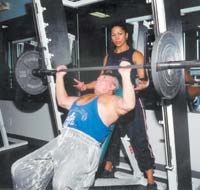
back

|
 |
Pumping
iron a key to healthful aging
By Larry Rand, The Daily
Press
September
30, 2003
Ia Anspach, a personal trainer and
competitive bodybuilder, watched a senior citizen lifting weights at
Gold's Gym.
 "The
older people, they amaze you," Anspach said. "The
older people, they amaze you," Anspach said.
She ran Dale Mack through his weight routine, which trainers call
"resistance training." Mack has the bulging muscles of a biker,
which he once was. He said he doesn't do big weights any more, but what
Mack is lifting looks pretty serious.
He works out five days a week, for 11/2 to two hours.
Oh, and he's 73 years old.
"Lifting weights is like banking money when you're young," Mack
said. "It doesn't just help with the quantity of life, but the
quality of life. I want to keep everything toned and performing as well as
I can for as long as I can."
One of the revelations inspired by John D. and Catherine T. MacArthur
Foundation research — which led to the classic book "Successful
Aging" — is that lifting weights is as important as cardiovascular
training for the health of older people.
A MacArthur researcher examined a group of frail people, as old as 98, who
lived in a nursing home. Three times a week for eight weeks, each of them
did 10 weight machines, working all the major muscle groups.
"The results were astounding," according to "Successful
Aging" authors Dr. John Rowe and Dr. Robert Kahn. "Muscle
strength increased 174 percent on average, and the walking speed of
individuals increased by 50 percent."
Researchers found that decreasing muscle size triggered brain activity
associated with the aging process. Enlarging atrophied muscles delayed the
effect and, in some cases, reversed it.
Diane Meireis of
Apple Valley
is 58 and lifts weights three times a week.
"Strength training makes a big difference," she said.
"There are so many misconceptions out there. You don't bulk up like
The Hulk. It's a great stress reliever, and I bounce back faster from
things like jet lag."
"It's not true that you get too old for training," Anspach said.
"You can still build it. The big benefits of free weights are
improved balance and working the individual limbs, instead of both
(limbs).
"The free weights work the small muscles, which contribute to
balance. On a machine, the strong arm will carry the weak, but using free
weights will even that out.
"I recommend resistance training for older clients two or three times
a week. I want them to walk six days.
"It's not good for them to rest too much — in 72 hours, you can
lose all the benefits of your last workout. Lifting once a week doesn't
pay off at all."
Lifting weights helps in weight control, too.
Increased muscle size requires more energy and raises the metabolism,
burning more calories.
Dr. Barry Sears, author of "The Zone," points out that
resistance training also stimulates the secretion of Human Growth Hormone,
a powerful rejuvenator.
Meireis said she was motivated to lift weights to prevent the onset of
osteoporosis, a weakening of the bones common in older women.
MacArthur Foundation studies showed that lifting weights also could
alleviate depression in older participants.
Anspach won't take older clients without written permission from their
doctors, but said she gets it "99 percent of the time."
"The secret to success," write Rowe and Kahn, "is to have a
thorough medical evaluation and to participate in supervised exercise
programs if you are at added risk."
Having a personal trainer is great supervision, Mack and Meireis agreed,
but the cost can range from $40 to $50 an hour, according to Anspach.
Finding a workout buddy is a viable alternative, if you can learn the
proper way to lift.
"People will progress at least twice as fast toward their goals using
a personal trainer," Anspach said, "and you have the added
benefit of personal interaction, which is key."
Personal engagement, as Rowe and Kahn call such interaction, is one of the
three keys to successful aging, along with avoiding disease and
maintaining high cognitive and physical function.
Copyright
© 2002 Global Action on Aging
Terms of Use | Privacy
Policy | Contact Us
|



